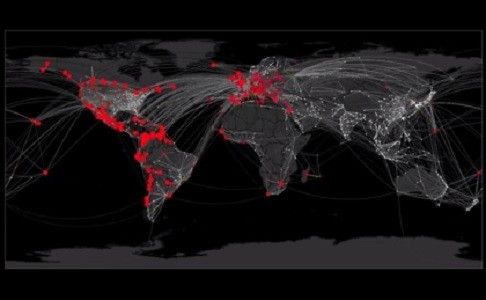Video Shows How Deadly Virus Would Spread Globally

A team of experts have created a video showing how a deadly virus would spread across the world.
As the world becomes increasingly connected, the spread of disease too becomes more mobile.
With over three billion passengers travelling by air every year, researchers have found that diseases and viruses can travel far faster and more effectively through busy airports than around cities in the same country.
Scientists at Berlin's Humboldt-Universität, ETH Zurich, Northwestern University and Robert Koch Institute developed a mathematical theory showing how a deadly virus would spread.
The simulation shows a hypothetical epidemic similar to the 2009 swine flu pandemic starting in Atlanta.
The film shows how the spread quickly becomes irregular with no apparent origin, showing how difficult it would be to predict arrival times in different countries around the globe.
Published in the magazine Science, the study looked to answer three questions to contain further spread: Where did the new disease originate? Where are new cases to be expected? When are they expected? And how many people will catch the disease?
Theoretical physicist Dirk Brockmann, from Berlin's Humboldt-Universität, and Dirk Helbing, from ETH Zurich, say their simulation shows how traditional models of disease spread are no longer valid.
"Our theory is based on the intuitive notion that in our strongly connected world, conventional geographic distances are no longer the key variable but must be replaced with effective distances," they said.
Helbing said: "If the flux of passengers from A to B is large, the effective distance is small and vice versa. The only thing we had to do was to find the right mathematical formula for this."
Brockmann added: "From the perspective of Frankfurt, Germany, other metropolitan areas such as London, New York or Tokyo are effectively not more distant than geographically close German cities such as Bremen, Leipzig or Kiel.
"With this new theory, we can reconstruct outbreak origins with higher confidence, compute epidemic spreading speed and forecast when an epidemic wave front is to arrive at any location worldwide. This may help to improve possible mitigation strategies.
"In the future, we hope that our approach can substantially improve existing, state-of-the-art models for disease spread."
© Copyright IBTimes 2025. All rights reserved.






















